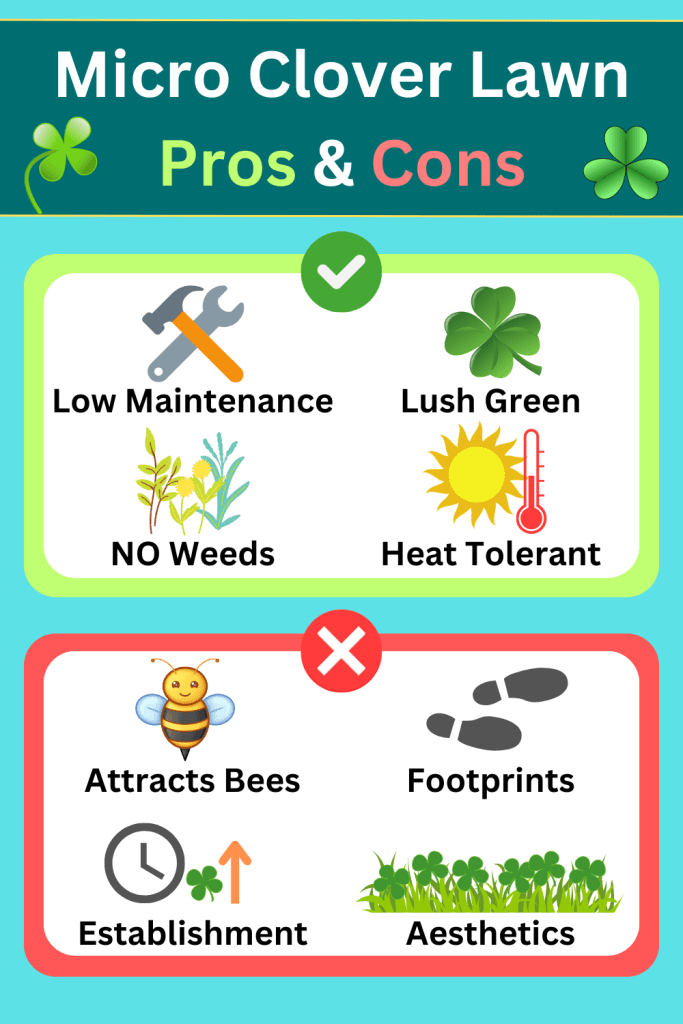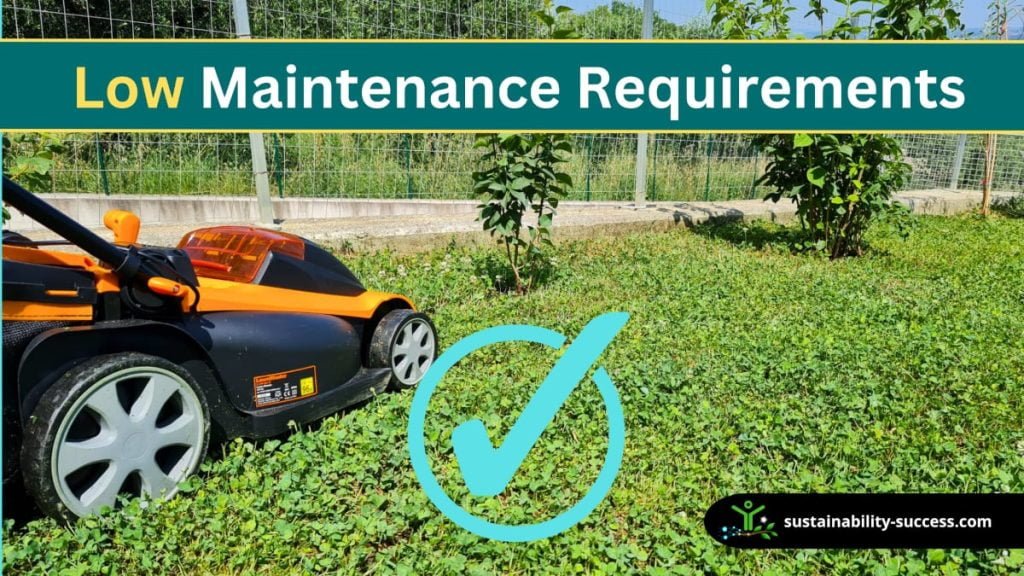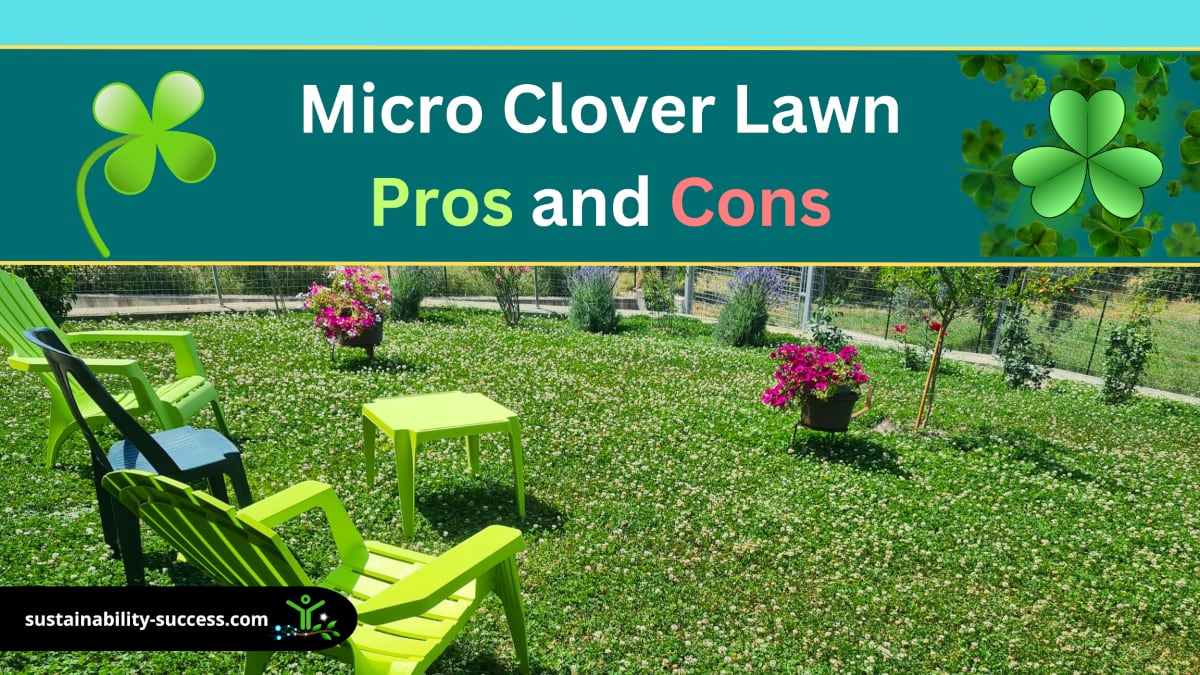My parents have a micro clover lawn, and I’m always been intrigued by innovative solutions that blend environmental benefits with practicality. In this article, I will explore the advantages and disadvantages of a micro clover lawn, shedding light on its unique benefits and drawbacks for those looking to embrace this eco-friendly alternative.
Key Takeaways
- Micro clover lawns offer environmental benefits, like improved soil health and reduced chemical use.
- They have low maintenance needs but can attract insects and have limited foot traffic tolerance.
- The appearance differs from traditional grass, with potential aesthetic and initial establishment considerations.

Here’s a quick summary of the micro clover lawn pros and cons:
| Pros | Cons |
|---|---|
| Improved soil health | Potential for insect stings |
| Reduced water and chemical usage | Limited tolerance to heavy foot traffic |
| Lush green appearance | Aesthetics not like a grass lawn |
| Low maintenance requirements | Initial establishment period |
| Tolerance of heat and sun exposure | |
| Pollinator attraction | |
| Enhanced biodiversity | |
| Weed suppression | |
| Nitrogen fixation | |
| Increased soil moisture retention |
The pros and cons of having a micro clover lawn should be carefully considered. On the positive side, micro clover provides natural fertilization, requires less mowing, and is drought-tolerant.
However, it can be invasive, be a nuisance to some people, and may not withstand heavy foot traffic. Ultimately, the decision to have a micro clover lawn should be based on individual preferences and specific circumstances.
Considering the pros and cons of a micro clover lawn is essential before making a decision.

PROS of micro clover lawns
Here are the main advantages of micro clover lawns:
1. Improved Soil Health
One of the significant benefits of a micro clover lawn is its ability to improve soil health. Clover helps reduce erosion, acting as a natural barrier against soil loss.
Additionally, it has the remarkable ability to enhance the fertility of the soil for other plants. Finally, clover doesn’t need chemical fertilizers, making it an environmentally friendly choice.
2. Reduced Water and Chemical Usage
Another advantage of a micro clover lawn is its capacity to conserve water. Clover has deep roots that retain moisture efficiently, thereby reducing the need for frequent watering.
This not only saves water but also minimizes the amount of chemicals, such as pesticides and fertilizers, required to maintain a healthy lawn. By reducing the usage of harsh chemicals, you play a part in preserving the health of the ecosystem and minimizing pollution.
3. Lush Green Appearance
The lush green appearance of a micro clover lawn is undeniably one of its standout benefits. Clover lawns provide a beautiful carpet-like covering that adds visual appeal to any landscape.
Unlike traditional turf lawns, micro clover stays vibrant and green throughout the summer, thanks to its resistance to drought. Embracing the natural beauty of a clover lawn can create an aesthetically pleasing environment that stands out.
4. Low Maintenance Requirements

If you’re tired of the constant maintenance of a traditional lawn, a micro clover lawn offers a compelling solution. These lawns have significantly lower maintenance requirements compared to traditional grass lawns.
Clover lawns grow slowly, reducing the need for frequent mowing and the also don’t need dethatching. They also require less watering and are generally pest and weed-resistant, which means less time and effort spent on lawn care.
5. Tolerance of Heat and Sun Exposure
A notable advantage of a micro clover lawn is its ability to tolerate heat and sun exposure. Unlike many grass varieties, micro clover retains its vibrant green color even under intense sunlight and high temperatures.
Its resistance to drought ensures that it remains green throughout the summer months without the need for excessive watering.
This makes it an ideal choice for regions with hot and/or arid climates, like Florida, Texas, Arizona, and the south of California.
6. Pollinator Attraction

Micro clover lawns offer a haven for pollinators such as bees and butterflies. These important pollinators play a vital role in the ecosystem and contribute to plant reproduction.
7. Enhanced Biodiversity
By creating a micro clover lawn, you can help support some crucial species and contribute to biodiversity. It’s a small step you can take to make a positive impact on the environment and promote a healthier ecosystem.
In fact, micro clover lawns are known to attract a variety of beneficial insects, such as bees and butterflies, which contribute to a healthier ecosystem.
This enhanced biodiversity promotes natural pest control and creates a thriving environment for other plants and animals. The presence of these beneficial insects helps to maintain a balanced ecosystem and supports the overall health of the lawn.
8. Weed Suppression
The dense growth of micro clover helps to suppress the growth of weeds in the lawn. By forming a thick mat, micro clover competes with weeds for sunlight, nutrients, and space.
This natural weed-suppression ability reduces the need for chemical herbicides and minimizes the labor and cost associated with weed control. A well-established micro clover lawn can effectively keep weeds at bay.
9. Nitrogen Fixation
Micro clover has the remarkable ability to fix nitrogen from the atmosphere into the soil. This means that it takes nitrogen gas from the air and converts it into a usable form for plants.
This natural nitrogen fixation provides a continuous natural source of fertilizer for the lawn, reducing the need for synthetic or chemical fertilizers. The result is a healthier and more sustainable lawn that helps to improve soil fertility over time.
10. Increased Soil Moisture Retention
One of the advantages of micro clover lawns is their ability to retain moisture in the soil. The dense growth of micro clover acts as a natural mulch, preventing evaporation and reducing water loss from the soil.
This can be particularly beneficial during dry periods or in regions with water restrictions. The improved soil moisture retention reduces the frequency of watering needed for the lawn, contributing to water conservation efforts.
CONS of micro clover lawns
Now that we’ve explored the pros and cons of micro clover lawns and the various benefits they offer, it’s important to consider any potential downsides as well.
Here are the main disadvantages of micro clover lawns:
1. Insect Stings
While micro clover lawns offer numerous benefits, it’s important to be aware of potential downsides. One such downside is the possibility of insect stings.
Bees are important pollinators that help gardens thrive, but for individuals with bee sting allergies, having a micro clover lawn may pose a hazard. Bee stings can cause severe allergic reactions, ranging from itching and swelling to difficulty breathing and even anaphylactic shock.
If someone in your family has a known bee sting allergy, it’s crucial to take necessary precautions when considering a micro clover lawn. Keep in mind that bees are attracted to clover flowers, so the presence of the micro clover lawn may attract more bees to your yard.
It’s important to assess the risk and consult with a medical professional if necessary to ensure the safety of everyone in your household.
Additionally, if rabbits live nearby, be aware that they love clover. Rabbit lawn damage can be quite severe, especially for micro-clover lawns. However, also grass lawns are not immune from rabbits.
2. Limited Tolerance to Heavy Foot Traffic
One possible drawback of micro clover lawns is their reduced ability to withstand frequent heavy foot traffic. While micro clover can generally tolerate regular usage like walking or playing on the lawn, it may not endure well in the face of repeated heavy use.
This is particularly evident in pure clover lawns, as they consist of shorter-lived perennial varieties that may necessitate reseeding every two to three years.
If you have a lot of foot traffic in your yard, such as children playing or frequent social gatherings, a micro clover lawn may not be the best option.
However, in mixed-lawns where micro clover is combined with traditional turf, the clover may reseed itself and better withstand heavy foot traffic. Assess your specific needs and usage patterns before deciding on a micro clover lawn.
3. Aesthetics not like a grass lawn
One potential drawback of micro clover lawns is that their appearance may differ from traditional grass lawns. While micro clover provides a lush, green cover, its leaf structure and texture may not exactly resemble the look of a classic grass lawn.
The presence of clover flowers, which are attractive to pollinators, can also add a unique touch to the lawn. Some individuals may prefer the uniform and manicured look of a traditional grass lawn, and find the visual differences of a micro clover lawn less appealing.
However, it’s important to consider that aesthetics can be subjective, and the preference for a grass-like appearance depends on personal taste. Many people appreciate the soft and vibrant carpet of micro clover, which can create a natural and charming ambiance.
The visual diversity brought about by micro clover lawns can add interest and uniqueness to outdoor spaces.
It’s worthwhile to evaluate whether the aesthetic variation provided by micro clover aligns with your desired lawn style, and consider the other numerous benefits that micro clover lawns offer to make an informed decision.
4. Initial Establishment Period
The process of establishing a micro clover lawn may require more time and effort compared to seeding traditional grass lawns. It involves properly preparing the soil, removing existing grass, and ensuring good seed-to-soil contact for optimal germination.
The initial establishment period typically involves frequent watering and monitoring to support the micro clover’s growth. However, once the lawn is well-established, the maintenance requirements are generally low, making the subsequent upkeep easier and more manageable.
Common Misconceptions
There are several common misconceptions surrounding micro clover lawns. Some people believe that having a clover lawn is undesirable or that it requires excessive maintenance.
However, these misconceptions often arise from a lack of understanding about the benefits and characteristics of micro clover lawns.
Micro clover lawns are actually low-maintenance alternatives to traditional turfgrass lawns. They require less mowing, have natural weed-suppressing properties, and provide environmental benefits such as improved soil health and reduced water and chemical usage.
Additionally, micro clover lawns can create a lush and green appearance, making them aesthetically pleasing.
FAQ
Will a micro clover lawn attract more pests?
Micro clover lawns are generally resistant to pest infestations. Clover itself is resistant to many common lawn pests. However, it’s important to note that bees may be attracted to the clover flowers, so individuals with bee sting allergies should exercise caution.
Will a micro clover lawn take over my garden?
While micro clover can spread and fill in empty spaces, it can be easily managed by regular mowing and occasional reseeding. It is generally less aggressive compared to other types of clover.
Can I walk or play on a micro clover lawn?
Micro clover lawns can withstand normal use, such as walking or light play. However, heavy foot traffic may cause damage, especially in pure clover lawns.


